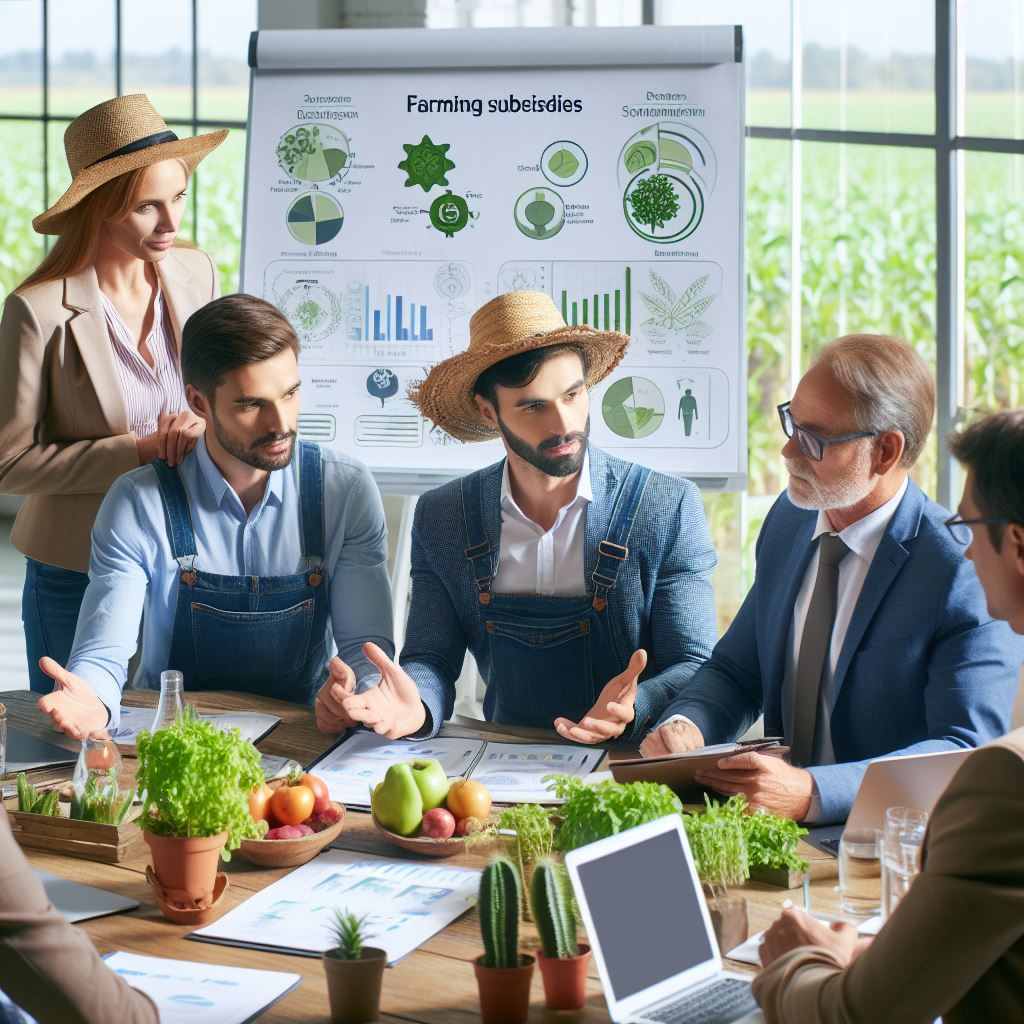2024: Changes in Farming Subsidies
Last Updated on February 16, 2024
Introduction
Farming subsidies are financial aids given to farmers to support their agricultural activities.
Farming subsidies
This play a crucial role in supporting farmers and ensuring stable food production.
These financial aids are provided by the government to help farmers overcome challenges such as unpredictable weather, market fluctuations, and high input costs.
Understanding changes in farming subsidies is essential as it directly affects the livelihoods of farmers and the overall agricultural industry.
Changes in farming subsidies can have a significant impact on the agricultural sector and its stakeholders.
It is crucial for farmers to be aware of upcoming changes to make informed decisions regarding their farming practices and investments.
This knowledge empowers farmers to adapt their strategies, maximize their profits, and sustain their operations.
Importance of understanding changes in farming subsidies
Additionally, understanding changes in farming subsidies is important for policymakers, agricultural organizations, and consumers.
It allows policymakers to shape effective agricultural policies and programs that meet the evolving needs of farmers and promote sustainable farming practices.
Agricultural organizations can provide valuable guidance and support to farmers based on this knowledge.
Consumers can better understand the implications of farming subsidy changes on food prices, availability, and sustainability.
Essentially, Understanding changes in farming subsidies is crucial for farmers and the agricultural industry.
Purpose of the blog post
The purpose of this blog post is to highlight the significance and implications of future farming subsidy changes.
Through this blog post, we aim to shed light on the significance of understanding changes in farming subsidies.
We will discuss the potential impact on farmers, the agricultural industry, and society as a whole.
By doing so, we hope to encourage informed discussions and actions that contribute to a thriving and sustainable agricultural sector.
Historical Overview of Farming Subsidies
Concept of Farming Subsidies
This refer to financial aids provided by governments or organizations to support agricultural activities.
These subsidies aim to ensure food security, boost production, and protect farmers from market fluctuations.
Overview of farming subsidies in the past decades
In the past decades, farming subsidies have played a significant role in shaping agricultural policies globally.
Many countries implemented these subsidies to stabilize farming income and encourage farm growth.
1. Subsidy programs in developed countries
- United States: The United States has a long history of providing subsidies to its farmers. Programs like the Farm Bill have been instrumental in supporting various agricultural sectors such as crop production, livestock, and dairy.
- European Union: The Common Agricultural Policy (CAP) is a major farming subsidy program in the EU. It offers financial support to European farmers, ensures a fair income, and promotes sustainable farming practices.
- Japan: Japan provides subsidies to its farmers through programs like the Agricultural and Livestock Basic Plan, focusing on agricultural research and development, land improvement, and disaster relief.
2. Subsidies in developing countries
- India: India’s farming sector receives subsidies through initiatives like Minimum Support Prices (MSP), which guarantee farmers a minimum price for their crops. Additionally, various input subsidies are provided to enhance productivity.
- China: China implements subsidies to stabilize and enhance its agricultural sector. Programs target rural development, irrigation systems, seed production, and technological advancements.
- Brazil: The Brazilian government supports its farmers through programs like the Program for Strengthening Family Agriculture (Pronaf), which offers credit, technical assistance, and price guarantees.
Impact of farming subsidies on agriculture and farmers
The impact of farming subsidies has been both positive and controversial, with arguments for and against their effectiveness.
1. Positive impacts
- Economic stability: Farming subsidies provide stability to farmers’ income, ensuring their financial security and preventing widespread bankruptcy.
- Food security: Subsidies incentivize farmers to produce more, ensuring an adequate supply of food for the growing population.
- Rural development: Investments in agricultural infrastructure and development projects through subsidies contribute to rural areas’ overall growth.
- Environmental sustainability: Subsidies can encourage sustainable farming practices by supporting organic farming methods, reducing chemical usage, and promoting biodiversity.
2. Controversies and challenges
- Market distortions: Subsidies can create imbalances in the market, leading to overproduction or dumping of products, which may harm farmers in other countries.
- Income inequality: Critics argue that subsidies often benefit large-scale commercial farms more than small-scale and family-owned farms.
- Dependency: Some farmers may become overly reliant on subsidies, hindering their ability to adapt to market changes or explore innovative agricultural practices.
- Environmental concerns: Critics claim that subsidies can encourage harmful practices, such as excessive water usage or increased monoculture.
In essence, farming subsidies have had a significant impact on agriculture and farmers worldwide.
While they provide economic stability, promote food security, and foster rural development, controversies surrounding market distortions, income inequality, and environmental challenges persist.
Striking a balance between supporting farmers’ livelihoods and ensuring sustainable agricultural practices remains a crucial task for policymakers.
Read: 2024 US Farm Bill: Key Changes Explained
Reasons for Changes in Farming Subsidies
In recent years, there have been significant changes in farming subsidies worldwide. These changes can be attributed to several key factors:
- Shifts in government policies and priorities: Governments may reconsider their approach to farming subsidies based on changing political ideologies or economic circumstances.
- Global economic factors influencing farming subsidies: International trade agreements and economic conditions can impact the allocation of subsidies to farmers.
- Environmental concerns and sustainability: With increased awareness of environmental issues, governments may adjust subsidies to encourage sustainable farming practices.
Shifts in government policies and priorities
Governments play a crucial role in shaping farming subsidies through their policies and priorities.
As political ideologies evolve, so do the ways in which subsidies are allocated.
For example, a government that once heavily subsidized large-scale industrial agriculture may shift its priorities towards supporting small-scale, organic farming.
This change may be driven by a desire to promote local food systems, reduce environmental impact, and improve public health.
Similarly, changes in political power can lead to shifts in farm subsidy programs.
A new administration or government may have different priorities that result in changes to subsidy allocation.
Global Economic Factors Influencing Farming Subsidies
The global economy and trade agreements have a significant influence on farming subsidies.
Countries often subsidize their agricultural sectors to provide a competitive advantage in international markets.
However, changes in global economic conditions can necessitate adjustments to subsidy programs.
For instance, if a country faces financial constraints or trade disputes, it may need to reduce or reallocate subsidies to meet other economic demands.
Moreover, international trade agreements, such as the World Trade Organization’s Agreement on Agriculture, can place restrictions on the types and amounts of subsidies allowed.
Compliance with these agreements may require governments to reassess their subsidy policies.
Environmental concerns and sustainability
Increasing environmental concerns and the need for sustainable farming practices have become driving forces behind changes in farming subsidies.
Governments are recognizing the importance of promoting environmentally friendly agriculture that minimizes negative impacts on ecosystems, water resources, and climate change.
As a result, subsidies are being redirected to incentivize practices that prioritize conservation, biodiversity, and natural resource management.
Support for organic farming, agroforestry, and regenerative agriculture is growing, as these methods are seen as more sustainable alternatives to conventional farming practices.
Subsidies may be used to help farmers transition to these methods or adopt more environmentally friendly technologies.
Furthermore, concerns about food security and the impacts of climate change are also influencing subsidy programs.
Governments are increasingly investing in research and development to enhance crop resilience, promote climate-smart agriculture, and mitigate the risks associated with changing weather patterns.
In review, the reasons behind changes in farming subsidies are multifaceted.
Government policies and priorities, global economic factors, and environmental concerns all contribute to the evolution of these subsidy programs.
As societies strive for sustainable and resilient agricultural systems, subsidy allocation continues to adapt to meet these evolving needs.
Read: Understanding the US-Canada Agri Trade Agreement
Potential Effects of Changes in Farming Subsidies
Impact on small-scale farmers
- Reduced subsidies may lead to financial difficulties for small-scale farmers.
- They may struggle to compete with larger farms without sufficient support.
- As a result, many small-scale farmers might be forced to abandon farming altogether.
- This could lead to a decline in the diversity of farming practices and crops grown.
- It may also result in a loss of traditional farming knowledge and skills.
Changes in agricultural practices and technology adoption
- Reduced subsidies might encourage farmers to adopt more sustainable agricultural practices.
- Farmers may focus on organic farming, conservation methods, and diversified crop rotations.
- This shift could result in improved soil health, reduced chemical use, and better environmental outcomes.
- Additionally, farmers might invest in advanced technologies to increase efficiency and productivity.
- Precision agriculture, automated machinery, and data analytics could become more prevalent.
Influence on food prices and availability
- Changes in farming subsidies may impact food prices due to shifts in production costs.
- Reduced subsidies could lead to increased production costs for farmers.
- Higher production costs might be passed on to consumers, resulting in higher food prices.
- In some cases, this could affect the affordability and accessibility of nutritious food.
- However, if subsidies are redirected towards supporting sustainable agriculture, it may stabilize food prices.
- Sustainable practices could also improve food availability by ensuring long-term resource management.
Case Studies: Country-Specific Changes in Farming Subsidies
Case studies can provide valuable insights into how different countries approach farming subsidies and the potential outcomes of policy changes.
By examining specific examples, such as the United States and the European Union, we can gain a deeper understanding of the challenges and opportunities that arise in the agricultural sector.
A. Example 1: United States
In the United States, farming subsidies play a crucial role in supporting the livelihoods of American farmers.
These subsidies, which include direct payments, crop insurance, and conservation programs, aim to stabilize farm income and ensure food security.
However, changes are expected in the near future as policymakers reevaluate the effectiveness and fairness of current subsidy programs.
Anticipated changes in farming subsidies in the United States could have wide-ranging implications for American farmers.
Potential shifts in subsidy allocation, reduction of certain subsidies, or implementation of new programs could affect the profitability and sustainability of farming operations.
It is essential for farmers to stay informed and adapt their strategies accordingly to navigate these changes successfully.
Example 2: European Union
In contrast, the European Union has a diverse agricultural landscape with varying subsidy structures across member countries.
Current farming subsidies aim to support European farmers, promote rural development, and ensure the production of high-quality food.
However, in light of evolving agricultural practices and changing global trade patterns, the European Union is considering significant reforms to its subsidy system in the next decade.
The proposed changes in farming subsidies within the European Union could have far-reaching consequences for the agricultural sector.
The focus may shift towards sustainability, ecological practices, and supporting smaller-scale farmers. However, there are concerns about the potential economic impact on larger farms and food prices.
Balancing the needs of different agricultural stakeholders will be crucial in shaping these future subsidy programs.
By exploring case studies like the United States and the European Union, we gain valuable insights into the complexities of farming subsidies.
These examples highlight the challenges faced by policymakers in supporting agricultural sectors while addressing broader societal and environmental goals.
It is important for countries to carefully evaluate the potential impacts of subsidy changes and ensure a smooth transition for farmers and the agricultural industry as a whole.
Read: Impact of NAFTA on American Agriculture in 2024
The Role of Technology in Shaping Farming Subsidies
Development and implementation of precision agriculture
- Advancements in precision agriculture have revolutionized farming practices.
- Precision agriculture uses technologies like GPS, sensors, and drones to enhance productivity.
- Accurate data collection enables farmers to optimize resource allocation and reduce costs.
- By adopting precision agriculture, farmers can increase yields and improve sustainability.
- These improved farming practices align with the goals of agricultural subsidy programs.
- Farmers utilizing precision agriculture may be eligible for subsidies that reward sustainable practices.
- Government support for precision agriculture can accelerate its adoption and bring about widespread benefits.
Impact of AI and automation on farming practices
- The integration of artificial intelligence (AI) and automation has immense potential in agriculture.
- AI-powered systems can analyze vast amounts of data to optimize farming decisions.
- Automation reduces manual labor, increases efficiency, and minimizes human errors.
- These technologies can improve crop management, livestock monitoring, and soil health.
- As AI and automation become more prevalent, farming subsidies may adapt to incentivize their adoption.
- Government subsidy programs can encourage farmers to invest in AI-driven farming technologies.
- Supporting AI and automation in agriculture can lead to increased productivity and sustainable practices.
How technological advancements may influence subsidy programs
- The rapid advancement of technology can significantly impact farming subsidy programs.
- New technologies can assist in tracking and monitoring farming practices more accurately.
- Data collected from advanced systems can verify compliance with subsidy program requirements.
- Technology enables governments to ensure that subsidies are directed towards deserving farmers.
- Remote sensing and satellite imagery can supplement traditional inspection methods.
- Technological advancements reduce administrative burden and streamline subsidy distribution.
- Incorporating technology into subsidy programs promotes transparency, efficiency, and fairness.
In general, technology plays a crucial role in shaping farming subsidies.
The development and implementation of precision agriculture have the potential to revolutionize farming practices, aligning with the objectives of agricultural subsidy programs.
Similarly, AI and automation can optimize farming decisions, improve efficiency, and lead to sustainable practices.
Technological advancements also enable governments to track and monitor farming practices more accurately, ensuring subsidies are directed towards deserving farmers.
Integrating technology into subsidy programs promotes transparency, efficiency, and fairness in the distribution of agricultural support.
By embracing these advancements, the farming industry can maximize productivity, reduce environmental impact, and contribute to a sustainable future.
Read: New Tariffs on Crop Imports: What You Need to Know

Potential Implications and Challenges
Risks associated with changes in farming subsidies
- Reduced subsidies may lead to financial instability for small-scale farmers.
- Withdrawal of subsidies might discourage innovation and technological advancements in agriculture.
- Farmers dependent on subsidies may struggle to find alternative sources of income.
- Changes in subsidies could lead to unequal competition and favor large agribusinesses.
- Without subsidies, some farmers may be unable to afford necessary inputs, affecting overall productivity.
- Less financial support may hinder farmers’ ability to adapt to climate change and sustainably manage resources.
- Reduced subsidies may result in increased food prices for consumers.
- The elimination of subsidies can lead to the consolidation of farmland, creating a loss of agricultural diversity.
- Changes in subsidies may also impact rural economies, leading to job losses in agricultural communities.
- Eliminating subsidies could potentially increase income inequality among farmers.
Ensuring equitable distribution of subsidies
- Implement transparent criteria for subsidy allocation to prevent favoritism and corruption
- Create mechanisms to support small-scale farmers and ensure they have equal access to subsidies.
- Provide targeted support for underrepresented groups within the farming community, such as women and minorities.
- Establish monitoring and evaluation systems to track the effectiveness of subsidy distribution.
- Promote cooperation between government agencies, NGOs, and farming organizations to improve subsidy distribution.
- Invest in education and training programs to enhance farmers’ knowledge on subsidy application and management.
- Consider regional variations and specific needs of different farming sectors when allocating subsidies.
- Encourage partnerships between farmers and retailers to ensure fair prices and distribution of subsidized produce.
- Seek public feedback and involve stakeholders in decision-making processes related to subsidy allocation.
- Regularly review and adjust subsidy policies to address any inequities or gaps in distribution.
Addressing the needs of diverse farming communities
- Develop tailored subsidy programs that account for the unique challenges faced by different farming communities.
- Incorporate sustainable agricultural practices into subsidy programs to promote environmental conservation.
- Support research and development in farming techniques suited for diverse farming communities.
- Increase funding for extension services to provide on-the-ground support and guidance to farmers.
- Invest in infrastructure development to improve access to markets and enhance the competitiveness of diverse farming sectors.
- Promote knowledge sharing and collaboration among farmers from different backgrounds through networks and platforms.
- Provide financial assistance for transitioning to alternative agricultural activities for communities affected by subsidy changes.
- Offer training and capacity-building initiatives to empower farmers in diverse communities.
- Engage with local communities to understand their specific needs and include their perspectives in policy-making.
- Encourage the preservation of traditional farming practices and cultural heritage within diverse communities.
All in all, the changes in farming subsidies can have various potential implications and challenges.
The risks associated with reduced subsidies require addressing financial instability, innovation discouragement, and unequal competition.
Ensuring equitable distribution is crucial through transparent allocation criteria, targeted support, and involvement of stakeholders.
Additionally, addressing the needs of diverse farming communities involves tailored programs, sustainable practices, and infrastructure development.
By carefully considering and implementing strategies, the potential negative effects of changes in farming subsidies can be mitigated, while maximizing positive outcomes for farmers and agricultural communities.
Conclusion
Recap of key points discussed
Throughout this blog post, we delved into the topic of changes in farming subsidies by 2024.
We examined the current state of farming subsidies, the potential shifts in policy, and the impact on farmers and the agricultural sector.
By scrutinizing the key points, we gained a deeper understanding of the evolving landscape of agricultural support.
Final thoughts on the future of farming subsidies:
As farming subsidies continue to undergo transformations, it is evident that their significance cannot be underestimated.
With shifting priorities towards sustainable practices, climate change mitigation, and the improvement of rural livelihoods, the future of farming subsidies presents both challenges and opportunities.
Implementing well-designed, targeted subsidies can play a crucial role in addressing these issues and ensuring a resilient and prosperous agricultural sector.
Encouragement for further research and engagement with farming subsidies topic
Understanding the complexities of farming subsidies and their future trajectory requires ongoing research and engagement.
It is essential for policymakers, researchers, farmers, and citizens to actively participate in the discussion, share insights, and contribute to the development of effective subsidy programs that align with evolving societal needs.
Only through collective efforts can we shape a sustainable and equitable agricultural system in the years to come.


